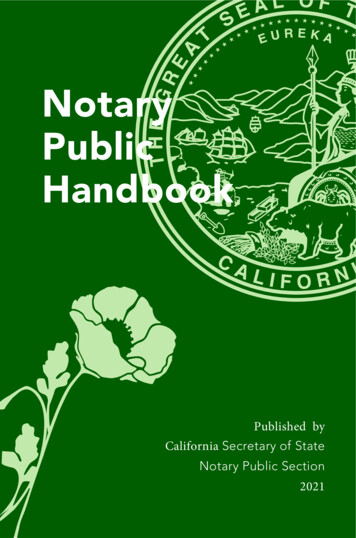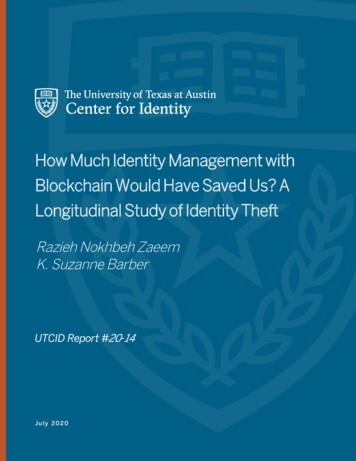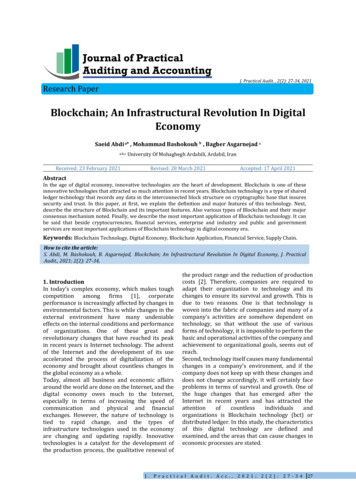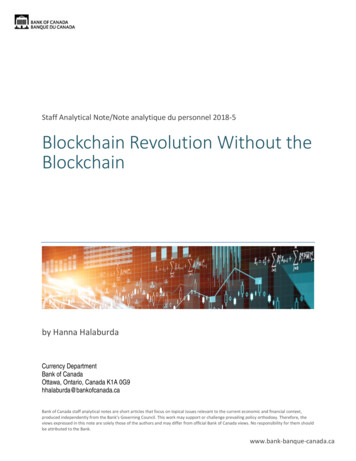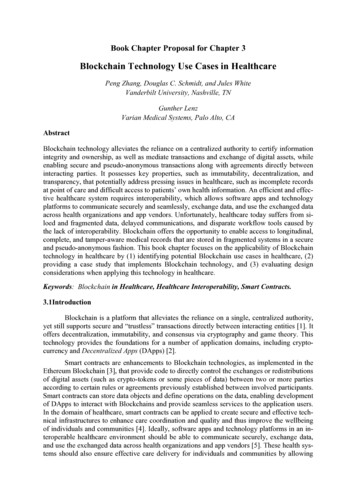
Transcription
“Ovidius” University Annals, Economic Sciences SeriesVolume XXI, Issue 1 /2021BlockChain (BC), Technology Notary inData Driven Marketing (DDM) ContractsErmal HaxhiajBia ÇeraUniversity of Tirana, Faculty of Economy, mAbstractToday, Data Driven Marketing is challenged by the supply of vague data, inconsistencies betweenthem and fraud through advertising in the digital marketing ecosystem. Through three basic conceptslike open ledger, distributed ledger, and miners, BlockChain (BC) is a perfectly positionedtechnology, restoring not only trust and transparency, but ensuring a greater uniformity oftransactions within a largely fragmented sector. BC makes DDM more directly and reliable,validating and analyzing each customer's movement in advertising campaigns. In BlockChain thetraditional principle that creates the positive correlation between fee and delivery time through the"Third Trust Party" becomes null because transparency is one of the basic properties of thistechnology, which on the other hand for DDM is the Achilles heel.Key words: chain, ledger, nodes, Merkle, Hash.J.E.L. classification: A10, A19, C68, L15, M15, M30, M31, M37, L86.1. IntroductionIt has been more than 12 years since Satoshi Nakamoto, the unknown person or group behindBitcoin, described how the BC technology, a distributed peer-to-peer linked structure, could be usedto solve the problem of maintaining the order of transactions and to avoid double-spending problems.Bitcoin orders transactions and groups them in a constrained size structure named blocks sharing thesame timestamp.The nodes of the network (miners) are responsible for linking the blocks to each other inchronological order, with each block containing the hash of the previous block to create a BC(Crosbyetal., 2016). BlockChain this innovative technology, is a system based on the digital currencytransaction. This technology has received a lot of attention recently due to the success of the mostpopular cryptocurrency, Bitcoin. Attention! BlockChain is not Bitcoin. BC serves as an account bookand immutable which allows transactions to take place in a decentralized manner. Applications basedon BC are being set up, covering many areas of the economy including financial services.The reputation of the Internet of Things (IoT) system, lately completing data driven marketing.BlockChain is effective as a registry (open book / legend) distribution technology, or DLT. Adistributed ledger is openly shared with all participants, and there are no private transactions, and itis decentralized. Cryptographic verification from block to block creates a chain of trust in thesetransactions. There are still many challenges to BC technology such as scaling and security issueswhich are still improving and thus the "gaps" displayed, to be overcome through three substantialconcepts on which BC technology is based. Suppose we have a network of fore people which arelabeled "nodes" eg: A (in Switzerland), B (in Albania), C (in Greece), and D (in Italy), who transfermoney between them. We continue the assumption by stating that initially in "Genesis", A has 10and from these he transfers to person B the value of 5. Under these conditions a transaction isperformed where we link the genesis with the transfer from A to B. Then, B transfers to D 3. Andso, from D to C are transferred 1.108
“Ovidius” University Annals, Economic Sciences SeriesVolume XXI, Issue 1 /2021Figure no. 1. A Open LedgerLegend:5 copyBANodesA 10 A B5 B D3 3 copyChainD CChainLink1 Open LedgerDSource: idea,Cfrom authors.1 Source: Authors’ ideaOpen LedgerThe three basic concepts on which BlockChain technology is built.i. Open Ledger, is the open and centralized registry only to the nodes that are part of this, andin this way is created a Chain with transfers (transactions), within an open register. Ledger is basicallya chain of transactions that is open and public to anyone. That is one of the reasons why it is calledBC. But what we mean by this open and public register? It is open and public, it means that any ofthe 4-people in the network can see where is, how much everyone has in their pocket and any ofthe people in the network can decide if a transaction is valid or not. If we want to transfer 15, thisis impossible because Genesis started at 10 and none of the nodes in the network (ABCD) has 15, so this transaction will not be active in this open legend. Such a transaction is not possible andthus cannot be part of the chain. Because we have a centralized location this means that Ledger doesnot have the option to provide 15 to complete the required transaction. But the primary goal of BCis to alienate centralization.ii. Distributed Ledger, is a distributed and decentralized register, and implies that BC ischanging form, from open and centralized to distributed and decentralized, beyond nodes in thenetwork. If we continue the assumption, illustrated as in Figure 1, node D may be creating a copy ofthe open legend of all transactions and meanwhile and A can do the same. When this copy becomesavailable for anyone to copy (not just those in Figure 1) to make the same for those who participatein this network, and give to someone who is not in this centralized group the opportunity to copy thesame, from other countries like Kosovo, Romania, Zealand, etc.Then we entered a partially decentralized legend as in figure2. Since we are dealing with differentcopies of this legend, BC ensures that all these copies are synchronized (coordinated) between them,and all participants who want to access in this network can see the same copy of the registry Ledgerand have the same version of it.a) To evaluate the new transaction, that it is a fact because B wants to transfer to C 5.b) Create an algorithm and find a special key which activates the mine to take over this transaction,and that after this to be able close the whole.To achieve this process, the mine calculates its own powers to know if it has the financial potentialand time to complete this transaction because this key is completely unpredictable. Through itsalgorithm, the mine generates keys to solve this random puzzle. Firstly, she must find the funding.In terms that it has financial capacity, it remains to be seen how ledgers are synchronized on thenetwork. Meanwhile from the assumption, mine D undertook to carry out the transaction between Bto C and record it. Later, she finds a way to network (publish) this transaction and to express that it109
“Ovidius” University Annals, Economic Sciences SeriesVolume XXI, Issue 1 /2021is a valid transaction. To have a dispersed (not open) state the legend must be decentralized. Figure1, transformed into the new outline Figure2. After D transmits and has completed the chain of thistransaction, then the key that performed it (࣭) closes it as a transaction.Figure no.2. Distributed LedgerLegend extra 1:copyBAB Ccopy5 DCMinersA B10 B D5 D C5 B C5 CryptographicKey on buted LedgerSource: Authors’ ideaIn short, BC is a dynamic form of book distribution technology based on the BlockChain concept,where each block represents a digital record of a bunch of valuable digital transactions. The structureand technology of BC is open, distributed and decentralized and so is its organization anddevelopment. Distributed Ledger (Register / Book / Legend), on the other hand, refers to all thosetechnologies that aim to facilitate connection to a shared database, designed to provide an assessmentof transactions and a consensus record. The technology behind the distributed ledger is a commonInternet game because the process is totally decentralized and transparent.iii. Miners, is also the basic and the most important principle of BC, illustrated below with Fig2.So, we had an open legend. It was seen from all nodes part of the centralized network, but withmining, it is understood that we now have a distributed legend of various nodes and decentralized.What remains to be understood is how these nodes are synchronized between them as best aspossible.To give a sense of this situation we are still assuming that B (in BC fig.2, where the legend isdecentralized, we mentioned that it does not matter where the node (person) is located and this wasone of the three practical advantages), will transfer to C a value of 5. Meanwhile nodes B transmits(publishes) and describes the transaction that has made it. Immediately anyone on the network seesand understands that B, wants to transfer 5 to C. This fact has not been yet billed (on paper). To bedocumented we must wait to clarify the new concept of Miners. These mines are special nodes, theyare waiting for a ledger (recording), to be closer to the explanatory mode, and to not add other nodesto complicate it, assume that A and D, are mines. The mines, now when the transaction are occursbetween B and C, decide who will be the first to accept this transaction and who will validate it. Nowone of the mines wins the "race" and finds a way to finance with digital currency. But how, one ofthese Mines win the transaction? To answer, in advance these two nodes make two moreassumptions:1. To evaluate the new transaction, that it is a fact because B wants to transfer to C 5.2. Create an algorithm and find a special key which activates the mine to take over this transaction,and that after this to be able close the whole. To achieve this process, the mine calculates its ownpowers to know if it has the financial potential and time to complete this transaction because this keyis completely unpredictable.110
“Ovidius” University Annals, Economic Sciences SeriesVolume XXI, Issue 1 /2021Through its algorithm, the mine generates keys to solve this random puzzle. Firstly, she must findthe funding. In terms that it has financial capacity, it remains to be seen how ledgers are synchronizedon the network. Meanwhile from the assumption, mine D undertook to carry out the transactionbetween B to C and record it. Later, she finds a way to network (publish) this transaction and toexpress that it is a valid transaction.To have a dispersed (not open) state the legend must be decentralized. Figure 1, transformed intothe new outline Figure2. After D transmits and has completed the chain of this transaction, then thekey that performed it (࣭) closes it as a transaction. In short, BC is a dynamic form of book distributiontechnology based on the blockchain concept, where each block represents a digital record of a bunchof valuable digital transactions. The structure and technology of BC is open, distributed anddecentralized and so is its organization and development. Distributed Ledger (register / book /legend), on the other hand, refers to all those technologies that aim to facilitate connection to a shareddatabase, designed to provide an assessment of transactions and a consensus record. The technologybehind the distributed ledger is a common Internet game because the process is totally decentralizedand transparent.There are different types of blockages in the ecosystem which will be addressed in the followingsub-topics. There are three types of BC: 1. Public; 2. Private; 3. Partnership / Consortium.Five basic principles underlying technology.1. Distributed database.2. Peer-to-Peer transmission.3. Transparency under a pseudonym (Anonymous).4. Irrevocability of Recordings.5. Computational logic.2. Literature reviewModern technologies put consumers at the forefront of security, privacy, trust, and transparencychallenges. BlockChain is transforming digital marketing by removing companies’ abilities to pulldata from customers without also offering to reimburse them for its value. Marketers can leveragethe technology’s positive attributes that customers are searching for in today’s digital landscape, bothin transparency and data protection. In terms of digital marketing, BC is one of the most importanttopics for its applications in the marketing field. Argues that each time individuals engage in anonline transaction (Prabhaker, 2000). They leave behind a digital trail of detailed information abouttheir identity, their buying preferences, spending habits, credit card details, and other personallyidentifiable information (PII) (i.e., data that can be used to identify a particular person). Onlinebusinesses regularly fail to meet regulatory requirements, and privacy leaks are frequent and have alasting impact on consumers' trust (Ingram et al, 2018); (Martin, 2018); (Bodoni, 2019).As a result, consumer awareness heightens, their suspicions raise, and they are more prudent aboutonline transactions as their (PII) can be used or sold for monetary gain without their permission(Norman et al, 2016). Avoiding online purchases is not a solution since brick-and-mortar retailersalso encourage the use of loyalty cards and maintain a centralized database which may be vulnerableto hacking or misuse. Moreover, many developing countries do not have privacy regulations in placeto protect consumers (PII). Therefore, brands must keep abreast of the latest privacy regulations,understand consumer expectations, and keep up to date with technology innovation and bestpractices. Advocates for enhanced consumer privacy suggest that systems should be built with a“privacy-by-design” framework (Cavoukian, 2011). The recent hype around BC technology has ledto promising use cases in areas such as finance, supply chain management, healthcare, tourism, realestate, and the marketing field is no exception. Initially launched for underpinning the cryptocurrencyBC. Technology and Applications for Digital Marketing provides insights on BC technology and itsapplications in digital marketing. This paper provides an orientation of how this technology isfunctioning within modern marketing and how it can influence the future of the digital marketingindustry. The applications of BC, benefits and challenges, disruptive innovations in digitalmarketing, privacy and security concerns, and the recent trends of BC in digital marketing. Theinherent characteristics of BC architecture and design provide properties like transparency,robustness, auditability, and security (Greenspan, 2015); (Christidis et al, 2016). A BlockChain can111
“Ovidius” University Annals, Economic Sciences SeriesVolume XXI, Issue 1 /2021be considered a distributed database that is organised as a list of ordered blocks, where the committedblocks are immutable.What BlockChain Could Mean for Marketing (Ghose, 2018)? BlockChain can make data-drivenmarketing more transparent by validating and analyzing every consumer’s journey through verifiedad delivery, confirming that a real person saw the ad as per the specifics of a media contract.Marketers will be able to control how their assets are delivered by monitoring exactly where theirads are being placed, alleviating ad fraud from automated bots by ensuring that real followers andconsumers are engaging with their ads, and ensuring proper ad engagement tracking that will lead tomore precise digital attribution. How consensus is reached in BC, between the nodes? This consensusis known as the Byzantine Generals' Problem (BG). The Byzantine fault tolerance concept originatesin the BG problem. The gist of the story: the Byzantine army has surrounded an enemy city. Thearmy is led by several Byzantine generals and each of the generals leads their own division. However,there are traitors among the generals who are interested in the Byzantine army failing. The BGproblem is a term etched from the IT science description of a situation where involved parties mustagree on a single strategy to avoid complete failure, but where some of the involved parties arecorrupt and disseminating false information or are otherwise unreliable. (Zheng et al, 2017).Marketing helps companies to understand and explain the value a consumer perceives and derivesfrom a product or service (Larivière et al, 2013). Despite uncertain financial returns, small firms arenow investing in fee-based technologies and platforms that they perceive as essential for sustaininga competitive position in their markets (Rishel et al, 1997). Digital marketing is leveraging newchannels across social media that provide firms with new, innovative, cost-effective, and influentialcapabilities to engage with customers (Melewar et al, 2017). In turn, customers are becoming anintegral part of the evolving engagement dialogue and are strengthening their influence on themarketing process (Berman and McClellan, 2002).3. Research methodologyThe internet-enabled technologies help the businesspeople to develop new digital markets and tomake new demands for their products and services. Thus, the internet-enabled technologies arecontributing a lot to the market engagement and customer target. Inline, a new technology calledblockchain has transformed the digital marketing process completely and helps to do the businesseffectively with accurate and up-to-date data. Like the marketing automation technologies redesignthe firms' outreach one side and increase the consumers' purchase intention on the other side, thusthe new generation marketing technologies shifting the customer-company relations to the newhorizons (Treiblmaie, 2018).Blockchain technology works by creating an environment that is secure and transparent for thefinancial transactions of virtual values. Hash codes of each block keep records safe in the blockchain.This is mainly because irrespective of the size of the information or document, the mathematical hashfunction provides a hash code of the same length for each block. So, attempting to change a block ofinformation would generate a completely new hash value (How Blockchain Technology Works,online 2019). A network that is open to everyone and concurrently maintains user’s anonymityundoubtedly raises trust issues regarding the participants. So, to build the trust the participants needto go through several consensus algorithms such as Proof of Work and Proof of Stake. The digitalcryptocurrency Bitcoin uses the first-ever blockchain technology (Amaba et al,2017).It is a digital store of value that enables peer to peer transactions over the internet without theintervention of a third party. The blockchain network is a decentralized structure that consists ofscattered nodes (computers) that inspect and validate the authenticity of any new transactions thatattempt to take place. This combine agreement is done through several consensus models by theprocess of mining (Baliga 2017). The process of mining demonstrates that each node trying to add anew transaction has gone through and solved the complex computational puzzle through extensivework and deserves to get a reward in return for their service.For the validation of a transaction, the network must confirm the following conditions: The senderaccount holds sufficient cryptocurrency balance that it intends to transfer (Prashanth Joshi, 2018).The amount intended to transfer has not already been sent to some other recipient. Once a transactionhas been validated and agreed upon by all the nodes, it then gets added to the digital ledger and112
“Ovidius” University Annals, Economic Sciences SeriesVolume XXI, Issue 1 /2021protected using cryptography that uses a public key that is accessible to all the other nodes and aprivate key that must be kept secret (Wachal, 2019).To maintain the transactions using digital currency in the blockchain network, we need tounderstand the digital wallet which is used to store, send, and receive digital currency (Li, X., Jiang2017). A digital wallet or a cryptocurrency wallet is a string of letters and numbers forming a publicaddress associated with each block in the blockchain. This public address is used whenever atransaction takes place; However, to prove the ownership of the public address there is a private keyassociated with the wallet that serves as the user’s digital signature that is used to confirm theprocessing of any transaction. The user’s public key is the shortened version of his private keygenerated through complex and advanced mathematical (Tschorsch et al, 2016).BlockChaine is not a cryptocurrency and should not be confused with cryptocurrencies such asBitcoin. Nowadays, cryptocurrency has become an everyday word both in industry and in academicsettings. When we use the word cryptocurrency the mind simultaneously goes to the most successfulcryptocurrencies, such as Bitcoin, Etherum, which have achieved great success with their capital inthe world market. With a special data storage structure, transactions on the Bitcoin network can occurwithout the involvement of any third-party intermediary, because at the core of the technology tocreate this cryptocurrency, is the BlockChain (which was launched in 2008 and implemented for thefirst time in 2009). Blockchain has brought a drastic change to technology in the last few years, andit is referred to as distributed ledger technology (DLT). The BC can be considered as the main publicbook that records and stores in the block all transactions that take place. This chain grows as newblocks are added to it constantly. From time to time, the hash digest of the last mined block is writteninto a public blockchain to guarantee immutability. The right to send transactions is granted byvalidator nodes to users by endowing them with the local Ethers mined. Overall, the proposedapproach has the same transparency and immutability of a public blockchain, without its drawbacks,(Marchesi et al, 2020).Marketers can leverage the technology’s positive attributes that customers are searching for intoday’s digital landscape, both in transparency and data protection. In terms of data drive marketing,blockchain is one of the most important topics for its applications in the marketing field. BlockchainTechnology and Applications for Digital Marketing provides insights on blockchain technology andits applications in digital marketing (Ramachandran et al, 2017).4. Findings4.1. What exactly can BC Technology do for DDM?Through this technology, many traders will be profitable and will not suffer the permanentproblems created from: Data inconsistencies; The challenges of an unclear supply chain; Advertisingfraud in today's digital marketing ecosystem.BlockChain is a perfectly positioned system to address these issues, restoring not only trust andtransparency, but ensuring greater uniformity of transactions, especially within a largely fragmentedsector. This will potentially revolutionize the way that marketers conduct their campaigns. Intelligentcontracts and self-executing agreements can be pre-coded with guidelines to evaluate impressions,ensuring that each meets a common standard.From what we refer in this paper, the premises are created to: have high uniformity in datastandards while offering greater assurance in terms that advertisers do not "pay" only for genuineimpressions of the service but to create the ideal premises in relation with visibility and everythingto be verifiable. This could potentially solve the permanent issue of the Achilles heel in DDM, whichstems from advertising fraud, which is estimated to capture 35 billion for a year. Simultaneously,as an immutable and distributed ledger BC can inject greater responsibility into a well-thought-outcampaign environment designed by marketers. Through BC, all actors of the marketing campaigninvolved, gain a complete and standardized view of all transactions that occur in real time. In aForrester report, for 2016, up to 56% of the entire on-screen advertising budget was lost in fraudulentinventory. The cost of advertising fraud worldwide is expected to rise to 50 billion over the nextdecade (A. Weissbrot, 2020).113
“Ovidius” University Annals, Economic Sciences SeriesVolume XXI, Issue 1 /2021A recent study on the state of programmatic advertising found that 79% of advertisers surveyedexpressed concerns about transparency, and by over a third about the lack of being exposed by thirdparties as one of their main concerns. Data-driven marketing accomplishes what was once almostimpossible to achieve due to data quality issues. A smart contract in the BC can fix this by providinga level of tracking and transparency that is currently realized by DDM. If consumers share more oftheir preference information, marketers will know more about them, which in turn will increase therelevance of their messages and decrease their advertising frequency. Natural transparency based onthe BC registry book can help companies gain consumer trust.From what we have encountered in today's theories through this modest paper, we can confirmwith conviction that BC helps to achieve innovation, increase transparency, refine data standards,and advance an integrated approach to quality service in those enterprises and digital marketingdriven industries. It can promote digital advertising to consumers, it is profitable in spending bigmoney on digital advertising campaigns. Under the new technology, consumers can share andimprove their statistics simultaneously with advertisers and advertisers. BlockChain technology canbe considered to restore data control to statistics researchers focused on digital advertising.4.2. Introducing BlockChain in Data Drive MarketingIn fact, consensus is an incredible transformation. But how to reach a consensus in a diffuse andhigh-risk environment, is a challenge. Equally a challenge for BC is how the network is distributed.BlockChain technology, there is no central node that ensures that the main registers in the distributednodes are all the same. Most of BC are currently used in financial markets. More and more apps arepopping up. Traditional industries can consider BC and implement it to increase their campaigns.User reputation can be stored in BC, but at the same time the emerging industry can use BC toimprove performance. BlockChain has shown its potential for transforming the traditional industrywith the features of its main: decentralization, persistence, anonymity, and auditing. In this paper, amore descriptive overview of BC is presented.By analogy, data-driven marketing, in the policies it harmonizes, is on the concept of creating asimple profitable business. In the primary mission that DDM has, it is interested in creating anaccomplished environment. To "catch in the air" the preferences of customers and create for themthe highest level of satisfaction. In this aspect, DDM uses BC systems to secure this mission. AfterBC was classified as a technological experiment, it has since taken the big step from theory topractice, and while technology continues to mature, we are seeing increased development solutionsthat are ready for enterprise. Today society is totally digitalized, and technology is playing a veryimportant role in the life of everyone (Ragothaman, 2021).BlockChain is a method which is useful in recording information and makes it difficult to change,hack or cheat with the system. A BlockChain is essentially a digital transaction volume book that isdistributed throughout the overall IT system network in the BC. This technology acts as a reliablelayer in the evolution of e-commerce. The spread of information, communication technology and ahost of smart internet business platforms came together with smart phone technology, which latercreated the internet of things, and thus changed the business landscape, restructuring their bodies andrenew the value creation process. In this way it facilitates the strategies of marketers to achieve adeeper level and a wider customer base from the personalized goals of the customers, thus increasingthe trust and loyalty of the customers towards a certain brand. Internet enabled technologies gave anunimaginable impetus to develop new digital markets and make new demands on the products andservices offered by marketers. Thus, technologies enabled by the internet are greatly contributing tomarket engagement and customer targeting. Whereas a new technology called BC, has completelytransformed the digital marketing process (data driven marketing) and helps to do business in aneffectively way with accurate and up-to-date data.Rigorous academic studies on blockchain applications in support of marketing activities arescarce. Despite this, in the practitioner-based literature, the benefits of blockchain are viewed asindisputable (Ghose, 2018). From a consumer-centric perspective, blockchain technology has thepotential to substantially transform consumer relationships by enhancing data and informationtransparency and improving privacy and security. It also allows for innovative forms of consumerloyalty programs which might help to create additional value. Data driven marketing, has114
“Ovidius” University Annals, Economic Sciences SeriesVolume XXI, Issue 1 /2021demonstrated how BC technology as a data science innovation based on data operates in thecustomer-centric model. The use of BC technology in digital marketing is still a concept that has justemerged.Figure no.3. Impact of blockchain on marketing.Source: https://www.frontiersin.org/The principal role of BC is to create secure digital registers and will also allow secure storage ofdata. Authors (Erragcha et al, 2021) in the book "Blockchain Technology and Applications forDigital Marketing" have given us an explanation of the meaning of the concept of BC technology,its principle of operation, as well as the different types and sectors of its applications, to make therelationship between BC technology and other emerging technologies, such as big data, AI and smartcontracts, to review the positive impact of BC technology on the e-commerce sector and in particularon customer relationship management as a key challenge in DDM.4.3. The challenge" of cryptocurrency in digital marketingOver the last few years, Cryptocurrency has developed, both in value and in comprehensiveness.Indeed, many indus
Data Driven Marketing (DDM) Contracts Ermal Haxhiaj Bia Çera University of Tirana, Faculty of Economy, Albania ermalhaxhiaj1916@gmail.com bia.cera@yahoo.com Abstract . Internet game because the process is totally decentralized and transparent. iii. Miners, is also the basic and the most important principle of BC, illustrated below with Fig2. .

